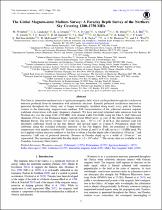The global magneto-ionic medium survey: polarimetry of the southern Sky from 300 to 480 MHz
Abstract
The Galactic interstellar medium hosts a significant magnetic field, which can be probed through the synchrotron
emission produced from its interaction with relativistic electrons. Linearly polarized synchrotron emission is
generated throughout the Galaxy and, at longer wavelengths, modified along nearly every path by Faraday
rotation in the intervening magneto-ionic medium. Full characterization of the polarized emission requires
wideband observations with many frequency channels. We have surveyed polarized radio emission from the
Northern sky over the range 1280–1750 MHz, with channel width 236.8 kHz, using the John A. Galt Telescope
(diameter 25.6 m) at the Dominion Radio Astrophysical Observatory, as part of the Global Magneto-Ionic
Medium Survey. The survey covered 72% of the sky, decl. −30° to +87° at all R.A. The intensity scale was
absolutely calibrated, based on the flux density and spectral index of Cygnus A. Polarization angle was
calibrated using the extended polarized emission of the Fan Region. Data are presented as brightness
temperatures with angular resolution 40′. Sensitivity in Stokes Q and U is 45 mK rms in a 1.18 MHz band. We
have applied rotation measure synthesis to the data to obtain a Faraday depth cube of resolution 150 rad m−2 and
sensitivity 3 mK rms of polarized intensity. Features in Faraday depth up to a width of 110 rad m−2 are
represented. The maximum detectable Faraday depth is ±2 × 104 rad m−2
. The survey data are available at the
Canadian Astronomy Data Centre.

